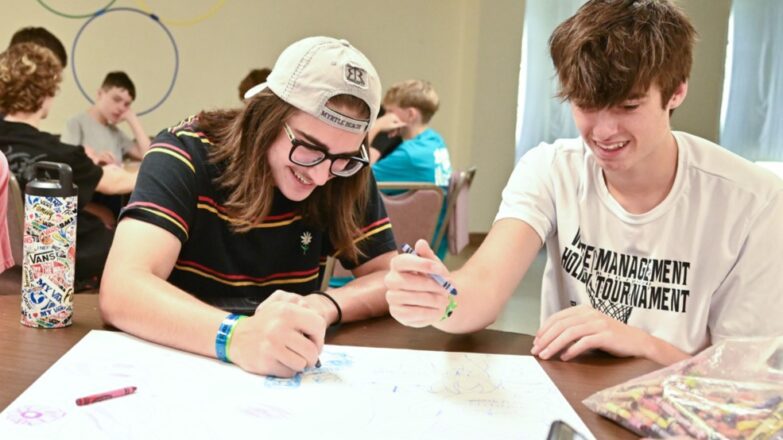This week, our Marketing Assistant, Kayden Foyles, began shadowing and working with summer staff from other departments to get an idea of how their work supports the Montreat experience. To help her communicate and share what she is experiencing, Kayden has been trained to collect information using a variety of creative writing techniques. Today, I would like to share a few of the strategies that she is utilizing in case you are interested in using them to document your own Montreat experience this summer.
Keeping a Visual Journal
The first tool that Kayden is using is a visual journal. Here, I’ve asked Kayden to keep track of her daily activities, writing down 4-7 things she did, 4-7 things she saw, and creating a visual representation, ideally a drawing, based on her day. This practice is largely inspired by cartoonist Lynda Barry, but it is advice that I have seen echoed by many creatives over the years. It is not something that you need to devote a lot of time to each day – half an hour is more than enough – but each minute you invest in documenting your life today will be repaid ten-fold when you look back on these memories later.
Now, you may think that your life is not interesting enough to bother writing about. (On the contrary, I think there is so much joy to be found in the mundane!) However, the point of this exercise is less about the details of your day and more about learning to pay attention to the world around you. By pushing yourself to remember what you see, hear, and experience, you will start to focus more on life in the moment. Additionally, the visual element of this exercise pushes you to draw from memory – a skill that requires you to pay attention to start with – rather than snap a quick picture on your phone. The result will be a story that is wholly unique to you.
Collect Your Thoughts Using a “Brain Dump”
If you are interested in writing a longer piece, it is important to take note of all relevant details. This summer, Kayden will be using a “brain dump” exercise as the starting point for each of her articles. To begin, take a piece of paper and draw a large X across the entire surface. Then, write down all of the words and phrases you can think of related to your topic. The X will keep you from listing things in order of importance: All ideas are welcome here, even if they don’t make it into your final piece. After about ten minutes, you should have a good idea of the themes you would like to discuss in your story.
Use Questions to Build an Outline
Each story we tell needs some kind of narrative arc. Once we know the general structure of our story, it becomes much easier to flesh out each idea. Here are some questions that Kayden is using to form a narrative outline for each of her articles:
- Who is my subject?
- What is their primary goal or desire?
- Why do they want that?
- What makes achieving that goal difficult?
- What was the outcome of the situation?
As you answer these questions, you will start to see your story take shape.
Pay Attention to Your Senses
Writing down what you see, hear, feel, taste, or smell in a situation can help you to immerse your reader in the story you are telling. Our senses can also help us to communicate complex emotions that may not be easy to put into words. This summer, Kayden will incorporate the sights and sounds of Montreat in her writing. And you can, too! Make note of what you see, hear, or feel as you explore Montreat this summer, trying to be as descriptive as possible. When reviewed later, the scenes you describe will transport you back to some of your favorite Montreat memories.
If you decide to try one of the techniques described above, please share what you create with us! We would love to hear about how Montreat is part of your story.
Next week, Kayden will share her first article about the summer staff who support our summer conferences. I hope you will give it a read!
Celeste Abney-Crowe is a creative services manager at Montreat Conference Center. She lives in Asheville, NC, with her husband Peter. In her free time, she enjoys drawing and painting scenes from life.

